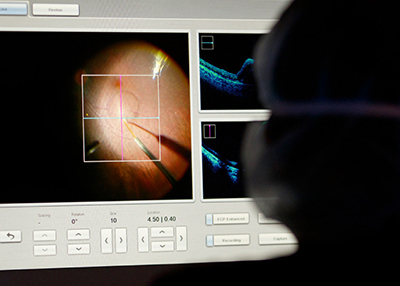
Pioneering a groundbreaking treatment
In 2018, OHSU Casey Eye Institute was one of the first three institutions in the country to administer the first federally approved gene therapy for retinal dystrophies. The Food and Drug Administration approved Luxturna™ (voretigene neparvovec-rzyl; Spark Therapeutics) in December 20 17. OHSU Casey Eye Institute treated two patients with the new gene therapy in August and September 2018.
“This is a pivotal moment for our field; it’s nothing short of historic,” said Mark Pennesi, M.D., Ph.D., chief of the Ophthalmic Genetics division at OHSU Casey Eye Institute. “The first trial was incredibly exciting, but even more exciting is the potential to change the whole field of ophthalmology and genetic disease. This success represents the tip of the iceberg. There are over 250 different genes that can cause these types of diseases. The fact that gene therapy can work for one indicates that many more may be treatable. At OHSU Casey Eye Institute, we have eight additional gene therapies in clinical trials and more on the way.”
OHSU Casey Eye Institute is conducting more ocular gene therapy trials than any other research center in the world. “We have been leaders in testing novel therapies for Usher syndrome, Stargardt disease, achromatopsia and X-linked retinitis pigmentosa,” Pennesi said. “In the coming year, we also plan to participate in the first clinic trial to use gene editing.”
Strong collection of resources to support gene therapy
Pennesi said a robust infrastructure in specialty personnel, advanced technology and surgical services is necessary to support gene therapy and its clinical trials. OHSU Casey Eye Institute is ideally positioned due to leadership’s commitment to support research into rare conditions.
“Many centers don’t have ophthalmic geneticists on staff, but here we have three,” Pennesi said. “We also have a fulltime genetic counselor and seven clinical trial coordinators. We have substantial, state-of-the-art diagnostic resources with trained technicians to measure whether a gene medication is working. But above all, we have a depth of collective experience among our retina surgeons working in a high-volume center.”
Exciting implications for the field
The first approved gene therapy is specific for biallelic RPE65 mutation-associated retinal dystrophy in children and adults. In clinical trials, more than 90 percent of people improved their vision, with some moving from legally blind to not blind.
“Although gene therapy won’t restore eye cells lost to disease, people who are treated in the early stages may look forward to a future without ever-diminishing eyesight,” Pennesi said. “We are entering an era of new therapy for those who otherwise would become irreversibly blind. For the first time, we are offering hope for these patients and their families and improving quality of life.”